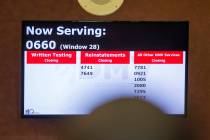Reforming pensions
For years various legislators and governors have talked about finding a way to cut the ballooning cost of state and local public employee pensions.
One suggestion has been to convert public employees from the current defined-benefit program to a defined-contribution system similar to 401(k) plans. Under defined-contribution plans, employers pay a fixed percentage of an employee's income into an investment portfolio. What the employee receives in retirement benefits depends on how well those investments do. Under defined-benefit plans, employees are guaranteed a set percent of their salary.
Knowing the debate is likely to arise in the 2011 Legislature, the Public Employees Retirement System of Nevada commissioned a study by a Chicago consulting firm to see what the cost of making such a switch would be. The Segal Co.'s report was released this past week.
They estimated the change would cost public employers and employees -- taxpayers -- an additional $1.2 billion over the next two years to prop up the system, but in 20 years or so a defined-contribution plan would be less costly.
There is no contemplation whatsoever that the state and local governments could do what other states have done for years -- refuse to fully fund the system and let its unfunded liability of roughly $10 billion grow in the short run, gambling on better tax revenue flows in the future.
The study pointedly spells out the difference between the public worker benefits and those in the private sector on Social Security. Someone who works 35 years (usually it is closer to 45 or 50 years) under Social Security, the Segal study observes, and retires at age 66 or 67 can typically expect a benefit of 25 percent to 40 percent of their highest salary. Someone earning $30,000 annually could expect about 40 percent of that salary as benefits, while those earning $90,000 would get only 25 percent. Under PERS' defined-benefit plan, Segal notes, a worker after 30 years might retire at 60 and be paid 75 percent of their highest pay. A $100,000-a-year employee would be paid $75,000 a year for life.
The study also assumes the public worker retirement plan is a "contract right" in perpetuity under "applicable case law," meaning the taxpayers might not be able to demand their employees pick up a greater share of their retirement cost.
Case law is determined by judges, who are covered by PERS. The retirement benefits are determined by lawmakers and local boards, councils and commission, who are covered by PERS. The executive branch, including the governor and attorney general, is covered by PERS.
No one has yet suggested the slightest hint of a conflict of interest.
There is one advantage to a defined-contribution plan that is seldom mentioned. There is, by definition, never an unfunded liability. The benefit is also portable. An employee can leave and take it with them.
As one union wag observed, states have kicked this can down the road for so long the can is now a 55-gallon drum. After one more kick down the road, it might be a tanker truck.
No one knows what can be done until someone tries.























